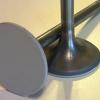Alright, some of you know about my build already, so I will bring others up to speed on what I have done so far and what my planes are for this motor.
First off, I bought a Military 6.5 N/A take out from Teds Trucks back 4 months ago. I planed to rebuild it 100% and have a strong motor for my "Horse hauler". I don't get in a hurry when building motors, I like to have lots of time and also things are done on a cash only basis with me...
When I tore it apart, it looked nearly new, I mean there wasn't even any black film on the inside parts, I think I got lucky....
This motor will have everything that turns, touches, slides against something, Ceramic coated in my shop by me. I did the porting of the heads and then coated the chambers & runners, this isn't my first time at doing this, but i will not advertise or try and sell anything in this thread either...
I will post pics of the things done to the motor so far, I am taking it to be balanced & machined Monday, then start the assembly. I will be using a DB2833 pump that will be set up by John at Unique Diesel, a Holset pro40 that will be turned into a hybrid by Ron Schoolcraft. I will not be finished with this build till the fall this year, it will be going into the truck in my sig and I have a NV4500 that will be going in at that time also.
Here are a few pics to start with..
The GEP heads have more metal in the runners and valve bowl than older heads do.
Half done
half done.
More to come...







 Reply With Quote
Reply With Quote






